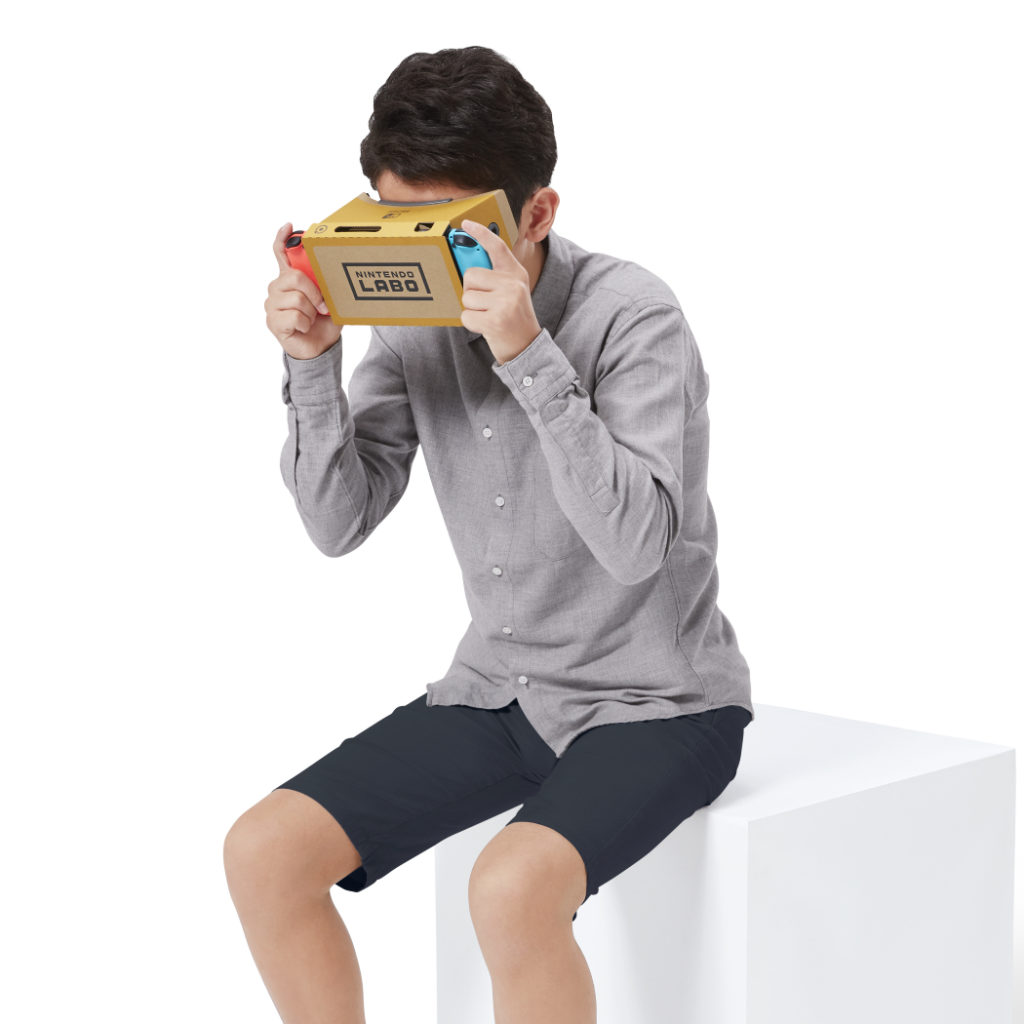Nintendo Enters VR Market with 'Build Your Own' Labo Headset
by on 8th Mar 2019 in News

Nintendo has revealed it is making an atypical move into virtual reality; Switch users will just have to build their own headset.
The news comes after the gaming giant announced the fourth release in its Labo line, which provides the Switch with a highly distinct hybrid of game and construction toy.
Labo kits contain everything players need to build elaborate mechanical controllers and other Switch peripherals. Each Labo kit also contains a game cartridge for the Switch, which includes lavish interactive building instructions, and a range of games that can be played with the assembled contraptions. The Switch's detachable Joy-Con controllers are inserted in each construction to provide the likes of motion sensitivity and vibration feedback, while linking each peripheral with the console itself.

The core Labo VR headset with the Switch inserted
Sturdy pre-cut cardboard serves as the main Labo building material, though the previous three kits have each included the likes of rubber bands and rope. The Labo titles are not explicitly education products, but there is a well-delivered leaning towards helping users understand the mechanisms they are creating.
The new Nintendo Labo: VR Kit is due 12 April, and will let users create a functioning VR headset that is built around the Switch's built-in screen. The set also lets users create mechanical extensions to the VR headset, to be used in the various included games. The extensions include a bird, elephant, and camera. If you've not seen or tried Labo yet, the notion of attaching a cardboard mechanical elephant to a home-built VR headset might be a little confusing. In reality, the Labo sets excel at making construction, mechanical engineering, and functional design simple and accessible. The kits also let users design their own contraptions and create simple games to interact with. And while the building materials may scream 'junk modelling' the quality and precision is remarkably high.
Still, it might be best to hand over to Nintendo's statement to clarify things.
"Nintendo Labo: VR Kit is the fourth kit in the Nintendo Labo series, providing the tools to make DIY cardboard creations called Toy-Con; play a variety of games with these creations; and discover how Nintendo Switch technology brings it all to life", the statement reads. "Nintendo Labo: VR Kit offers six new Toy-Con creations to build, including the Toy-Con VR Goggles, which combine with the other creations, encouraging players to use natural movements and gestures to interact with the gaming world and elevating the Nintendo Labo gameplay experience. Fend off an alien invasion with the Toy-Con Blaster, visit a colourful in-game ocean and snap photos of the sea life with the Toy-Con Camera, and so much more."
Here at TheGamingEconomy, we have happily built everything available in the previous Labo kits, and can vouch for their quality. But why is the imminent arrival of this fourth release significant?

A user looking into a combined VR headset and mechanical bird. Nintendo is never afraid to do things differently.
For one, Nintendo is making its move on VR sometime after the hype around virtual reality saw the PlayStation VR, Oculus Rift, and HTC Vive battle to dominate the space. Indeed, you could say that hype has now waned to a degree. Equally, the last time Nintendo made a serious attempt at offering consumer VR was with the less-than-perfect Virtua Boy almost 25 years ago. Ever since, industry and users alike have been pondering if Nintendo could shake up the virtual reality market.
The boom in virtual reality – that arguably started with the sensationally popular Kickstarter campaign for Oculus' Rift headset in 2012 – has seen its fair share of success, but VR headsets remain far from an everyday consumer device. There are numerous reasons for that, but perhaps the most significant factor is that virtual reality arrived with polarised hardware options. There were expensive high-end options that required a game console or powerful PC, or incredibly cheap options like the Google Cardboard, that allowed users to slot an ordinary smartphone into a simple cardboard frame. The high-end options were prohibitively expensive for many, while the mobile-based options delivered much lower quality content, potentially offering an underwhelming first impression for many consumers.
If Nintendo can make a success of the new Labo Kit, they will potentially offer a mid-level option that combines affordable hardware and relatively high-quality content. While Labo uses the same base material as Google Cardboard, based on previous sets the final headset is likely to be a great deal more durable, refined, and capable. It should be noted that Google has long since abandoned Cardboard for the more substantial Daydream mobile VR platform. Other 'high end mobile VR' options also now exist, including Samsung's Oculus-based Gear VR.
Nintendo's new VR Kit may present an interesting new mid-tier VR option; but even if successful, it could continue to exist as an isolated success as a single product. Labo has not yet emerged as a wildly open platform. The steering wheel for the Labo Vehicles Kit could be used in Mario Kart 8 Deluxe and Moto Rush GT; and some developers are moving to build games that employ Nintendo's cardboard peripherals. But Labo is yet to serve as a platform for numerous external releases. For the VR Kit to emerge as a truly significant virtual reality platform, it will need to be supported by a great deal more content not included in the original set.
As such, Nintendo's move on VR is best understood as 'interesting' rather than groundbreaking. But when the company behind Mario enters new territory, anything could happen.
The Nintendo Labo: VR Kit is available as a full bundle, or as a stripped-down starter set that can be bolstered with extra builds at a later date.







Follow TheGamingEconomy